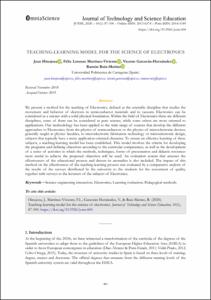Mostra el registre d'ítem simple
Teaching-learning model for the science of electronics
| dc.contributor.author | Hinojosa, Juan |
| dc.contributor.author | Martínez Viviente, Félix Lorenzo |
| dc.contributor.author | Garcerán Hernández, Vicente |
| dc.contributor.author | Ruiz Merino, Ramón |
| dc.date.accessioned | 2020-05-07T11:40:02Z |
| dc.date.available | 2020-05-07T11:40:02Z |
| dc.date.issued | 2020-04 |
| dc.identifier.citation | Hinojosa, J. [et al.]. Teaching-learning model for the science of electronics. "JOTSE: Journal of Technology and Science Education", Abril 2020, vol. 10, núm. 1, p. 87-100. |
| dc.identifier.issn | 2013-6374 |
| dc.identifier.issn | 2014-5349 |
| dc.identifier.uri | http://hdl.handle.net/2117/186687 |
| dc.description.abstract | We present a method for the teaching of Electronics, defined as the scientific discipline that studies the movement and behavior of electrons in semiconductor materials and in vacuum. Electronics can be considered as a science with a solid physical foundation. Within the field of Electronics there are different disciplines, some of them can be considered as pure science, while some others are more oriented to applications. Our methodology has been applied to the wide range of courses that develop the different approaches to Electronics, from the physics of semiconductors or the physics of microelectronic devices, generally taught at physics faculties, to microelectronic fabrication technology or microelectronic design, subjects that typically have a more application-oriented character. To ensure an effective learning of these subjects, a teaching-learning model has been established. This model involves the criteria for developing the programs and defining objectives according to the curricular competences, as well as the development of a series of activities in which the methods, techniques, forms of presentation and didactic resources most useful to achieve the proposed objectives will be used. An evaluation system that assesses the effectiveness of the educational process and detects its anomalies is also included. The impact of this method on the effectiveness of the teaching-learning process was evaluated by a comparative analysis of the results of the surveys distributed by the university to the students for the assessment of quality, together with surveys to the lecturers of the subjects of Electronics |
| dc.format.extent | 14 p. |
| dc.language.iso | eng |
| dc.publisher | OmniaScience |
| dc.rights | Attribution-NonCommercial 4.0 International |
| dc.rights.uri | https://creativecommons.org/licenses/by-nc/4.0/ |
| dc.subject | Àrees temàtiques de la UPC::Ensenyament i aprenentatge::Metodologies docents |
| dc.subject.lcsh | Educational evaluation |
| dc.subject.lcsh | Electronics--Study and teaching |
| dc.subject.lcsh | Education -- Study and teaching |
| dc.subject.other | Science-engineering interaction |
| dc.subject.other | Electronics |
| dc.subject.other | Learning evaluation |
| dc.subject.other | Pedagogical methods |
| dc.title | Teaching-learning model for the science of electronics |
| dc.type | Article |
| dc.subject.lemac | Electrònica -- Ensenyament |
| dc.subject.lemac | Avaluació educativa |
| dc.subject.lemac | Pedagogia |
| dc.identifier.doi | 10.3926/jotse.604 |
| dc.identifier.dl | B-2000-2012 |
| dc.description.peerreviewed | Peer Reviewed |
| dc.rights.access | Open Access |
| local.citation.publicationName | JOTSE: Journal of Technology and Science Education |
| local.citation.volume | 10 |
| local.citation.number | 1 |
| local.citation.startingPage | 87 |
| local.citation.endingPage | 100 |


